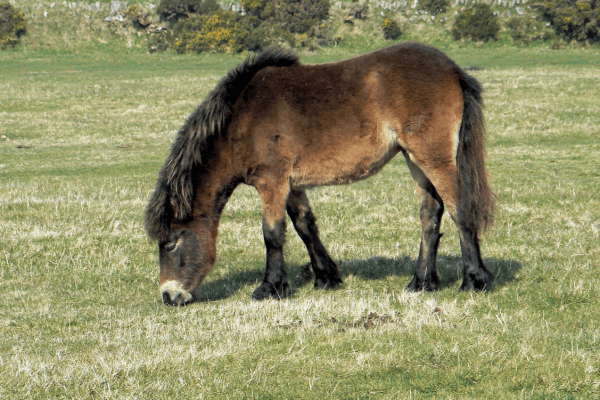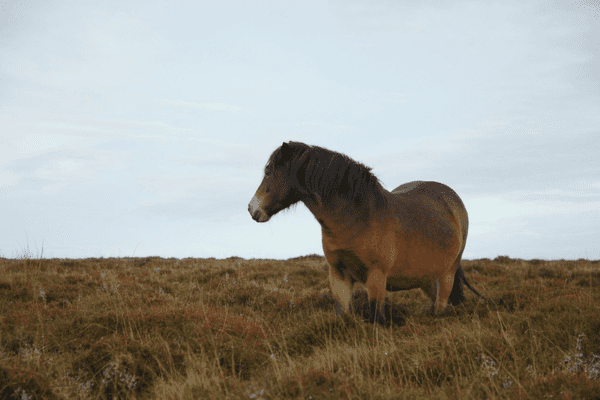“The Exmoor Pony, an emblematic breed of the British Isles, finds its origins in the Exmoor area, a vast expanse of moorland that spans north-eastern Devon and western Somerset in England’s south-western corner.
Renowned for its robust nature and small stature, this breed is perfectly suited to the harsh environmental conditions and limited forage of its native moor. Notably, some members of this breed continue to grace the moors of Exmoor, living in conditions that echo their near-feral heritage.
History:
The Exmoor Pony, with its roots firmly anchored in British history, tells an impressive tale of survival, adaptation and human influence. This narrative weaves point-by-point details with more expansive description to provide a look into this remarkable breed’s journey:
Ancient Records and Royal Ownership:
The Exmoor Pony first appears in ancient records during 1086 in the Domesday Book. Thanks to royal ownership, these ponies roaming Exmoor were exempt from taxation due to being exempted from census counts; furthermore, multiple Wardens over time contributed their expertise toward managing and improving pony breeds through grazing fees or selective breeding.
18th Century Developments:
The breed’s development during the 18th century is marked by key figures like Warden Sir Thomas Acland and diverse pony sales records dating from 1805-1809. These sales exhibit a wide array of colors in their pony population such as black, grey, bay dun and chestnut–indicating a wider genetic pool than was once believed.
Dividing Breeding Strategies:
John Knight’s purchase of the Royal Forest marked an inflection point, and Sir Thomas Acland, as Warden at that time, chose thirty “old type” ponies to be preserved at Ashway Side while Knight initiated crossbreeding programs with Arabians and Thoroughbreds that fundamentally altered its future.
Exmoor Pony Society and Breed Standards:
Breeding efforts during the late 19th and early 20th centuries focused on defining and protecting Exmoor Pony breed characteristics such as its mealy muzzle. One key step taken toward this end was when, in 1921, an organization called Exmoor Pony Society was created, initially accepting more diverse colors before tightening down its breed standards over time.
World War II Impact:
World War II had a devastating impact on Exmoor ponies, with their population rapidly decreasing due to military needs and exigencies. This period marked an alarming decrease in numbers which revealed their fragility.
Post-War Revival and Global Spread:
Mary Etherington’s efforts in the postwar era were instrumental in revitalizing and spreading Exmoor pony breeding across the world. Exports to Canada and Europe helped further establish this breed globally.
Conservation and Management in Modern Times:
Since the 1980s, Exmoor colts have been actively engaged in nature reserve management throughout the UK by aiding vegetation control. Since 2000, their involvement in conservation efforts was further reinforced with the creation of the Moorland Mousie Trust to focus on colt welfare and training needs of Exmoor colts.
Contemporary Challenges and Preservation Efforts:
Although Exmoor pony populations have reached significant global numbers, breeding concerns raised by organizations like the UK Rare Breeds Survival Trust remain. To protect this unique breed and ensure its survival, efforts continue to preserve it by maintaining genetic diversity while safeguarding survival.
Genetic Studies and Historical Significance:
Genetic research offers insight into the breed’s roots, hinting at a mixture of ancient and domesticated lineages. Furthermore, an Exmoor pony’s close resemblance to extinct Tarpan suggests a deep-rooted heritage linking them back to Britain’s prehistoric past.
Archeological Connections:
The breed’s history interweaves with larger historical narratives, from Roman involvement in mining on Exmoor to ancient Britons using horses-drawn transport for transportation. These connections underscore its significance beyond its physical characteristics by showing its role in human history.
Exmoor Ponies’ history spans millennia, from ancient records and evolutionary changes to societal impacts and modern conservation initiatives – each contributing to our knowledge of this unique breed that represents both nature’s resilience and human influence.

Characteristics of Exmoor Ponies:
The Exmoor pony stands as an emblematic breed for resilience and adaptability, possessing distinct features that set it apart from other breeds of horses.
Coat Color and Markings:
Exmoor pony coats generally exhibit dark bay tones commonly referred to as “brown”, with some individuals showing lighter “bay” shades. Rarer still are dun-colored Exmoors accepted into breed registries. A notable trait among Exmoors are their pangare or “mealy” markings – visible around eyes, muzzle, and underbelly – an ancestral trait found across different equine species – that make for easy identification when out riding or working – something white markings cannot do in terms of breed standard eligibility requirements!
Size and Stature:
Exmoor ponies typically range in size between 11.1 to 12.3 hands (45-51 inches, 114 to 130 cm), with mares typically reaching 12.2 hands (50 inches or 127 cm) while stallions/geldings reach 12.3 hands. Some may reach as tall as 13.2 hands.
Build and Physicality:
Known for their sturdy physique, Exmoor ponies are known for being deceptively strong for their size. Exmoor pony’s physical characteristics include deep chest, broad back with level croup and short but well-formed legs with strong bones and hard hooves – characteristics which demonstrate remarkable endurance in these animals.
Head and Facial Features:
An Exmoor pony’s head is relatively large relative to its body, with small yet well-shaped ears. One distinctive adaptation is the “toad eye”, raised flesh above and below each eye that serves to deflect water away and provide extra insulation against harsh weather conditions. This feature can prove especially valuable during severe storms.
Winter Coat and Insulation:
Exmoor dogs are well adapted to cold environments, where their thick winter coat features both a woolly underlayer for insulation purposes, as well as longer oily hairs on top. This double layer helps prevent their undercoat from getting waterlogged by channeling excess liquid away from their bodies; further protecting themselves with thick manes and tails which offer extra protection from the elements.
Jaw Structure and Misconceptions:
Contrary to some beliefs, Exmoor pony do not possess a unique jaw structure with an extra molar as has been suggested by misinterpretations of a German study that actually refers to an additional blood supply branch located within their lower jaw which is shared among several breeds with large lower jaws.
Snow Chutes:
One striking characteristic of an Exmoor pony is their “snow chutes”, an array of short, coarse hairs found at the dock of their tail that serve to deflect rainwater away from sensitive areas and direct it down their hind legs instead.
The Evolving Roles of Exmoor Ponies:
The Exmoor Pony, once an integral component of traditional hill farming on Exmoor moors, has undergone dramatic change over the years. Before agricultural mechanization became widespread, these hardy creatures played an essential part in rural life serving many practical purposes.
Agricultural and Rural Roles:
When first removed from moorland herds and trained as farm animals, Exmoor ponies proved invaluable in various agricultural tasks, from ploughing, harrowing, and shepherding to riding harness work and harness riding – they even found ways off of Exmoor to contribute as pit ponies in different regions!


Transition to Leisure and Competition:
With mechanization steadily dismantling traditional farming roles, Exmoor ponies found new life as leisure horses and equestrian sports horses. Both moorland-bred and those raised on farms or studs began participating in competitive showing, long distance riding, driving and agility activities; Stowbrook Jenny Wren won the NPS Bailey’s Horse Feeds Ridden Mountain & Moorland Championship at Olympia Christmas Show 2003 while also winning both International Horse Agility Championships 2011 and 2012 to show their agility and adaptability.
Conservation Grazing and Habitat Management:
Exmoor ponies have an important modern role to play in conservation grazing and habitat management. Their hardiness, varied diet, and unique dentition make them particularly adept at managing diverse landscapes such as heathlands, chalk grasslands and natural pastures – in doing so contributing not only to Exmoor’s preservation but also other ecological habitats.
International Impact and Biodiversity:
One major event in Exmoor ponies history occurred in January 2015 when fourteen were exported from Exmoor National Park breeders to Czech Republic for conservation grazing to enhance biodiversity at former military base Milovice in Milovice. This initiative has seen remarkable success; now there are 111 Exmoors participating.

